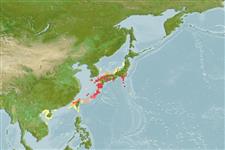>
Syngnathiformes (Pipefishes and seahorses) >
Syngnathidae (Pipefishes and seahorses) > Syngnathinae
Etymology: Hippocampus: Greek, ippos = horse + Greek,kampe = curvature (Ref. 45335); japapigu: Name from the colloquial Japanese name, Japapigu or Japan pig or 日本のピグミータツノオトシゴ.
Environment: milieu / climate zone / depth range / distribution range
ນິເວດວິທະຍາ
ສັດທະເລ ກ່ຽວກັນຫີນ; ລະດັບຄວາມເລິກ 5 - 22 m (Ref. 118476), usually 10 - 13 m (Ref. 118476). Subtropical
Northwestern Pacific: Japan and Chinese Taipei.
ຂະໜາດ / ນ້ຳໜັກ / Age
Maturity: Lm ? range ? - ? cm
Max length : 1.6 cm SL ຕົວຜູ້/ບໍ່ມີເພດ; (Ref. 118476)
Short description
ຕົວທີ່ໃຊ້ໃນການຈຳແນກຊະນິດ | ສະລີລະວິທະຍາ | ການວັດແທກຮູບຮ່າງລັກສະນະພາຍນອກຂອງດິນ,ສັດ,ປາ…
ຄີຫຼັງຂອງປາ (ຄີອ່ອນ) (ທັງໝົດ) : 14. This species is distinguished from its congeners by the following set of characters: 28 tail rings; 14 dorsal fin rays; 9 pectoral fin rays; 4 subdorsal rings; bilaterally paired wing-like protrusions are formed by a pair of large truncate spines projecting laterad on first superior trunk ridge; elevated dorsal ridge is formed by unique triangular bony mounds dorsally on second, the third and fourth trunk rings with the posterior mound less pronounced; a large and prominent spine projecting laterad on eighth lateral trunk ridge (Ref. 118476).
This species was not associated with a particular host. It has been observed in association with mixed soft coral, Halimeda sp. (coralline algae) and hydroids on rocky reef walls and large boulders in both exposed and semi-sheltered locations (Ref. 118476)..
Life cycle and mating behavior
ການຈະເລີນເຕັມໄວ | ການສືບພັນ | ການວາງໄຂ່ | ໄຂ່ | ຄວາມດົກຂອງໄຂ່ປາ | ຕົວອ່ອນ
Short, G., R. Smith, H. Motomura, D. Harasti and H. Hamilton, 2018. Hippocampus japapigu, a new species of pygmy seahorse from Japan, with a redescription of H. pontohi (Teleostei, Syngnathidae). ZooKeys 779:27-49. (Ref. 118476)
IUCN Red List Status (Ref. 130435: Version 2024-2)
Threat to humans
Harmless
Human uses
ເຄື່ອງມື
Special reports
Download XML
ແຫຼ່ງອີນເຕີເນັດ
Estimates based on models
Phylogenetic diversity index (Ref.
82804): PD
50 = 0.5000 [Uniqueness, from 0.5 = low to 2.0 = high].
Bayesian length-weight: a=0.00447 (0.00175 - 0.01142), b=2.99 (2.77 - 3.21), in cm total length, based on LWR estimates for this (Sub)family-body shape (Ref.
93245).
ຊັ້ນເຂດຮ້ອນ (Ref.
69278): 3.0 ±0.5 se; based on size and trophs of closest relatives
ຄວາມຢືດຢຸ່ນ (Ref.
120179): ສູງ, ປະຊາກອນຕຳ່ສຸດທີ່ໃຊ້ເວລາສອງໜ້ອຍກວ່າ 15 ເດືອນ (Preliminary K or Fecundity.).
Fishing Vulnerability (Ref.
59153): Low vulnerability (10 of 100).
